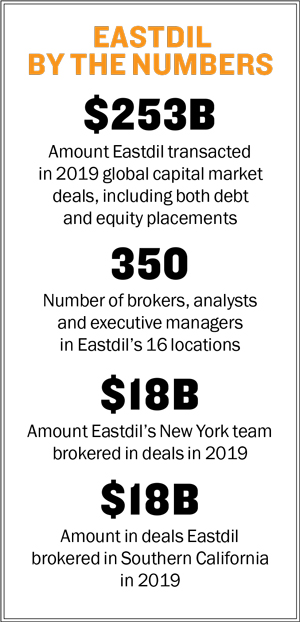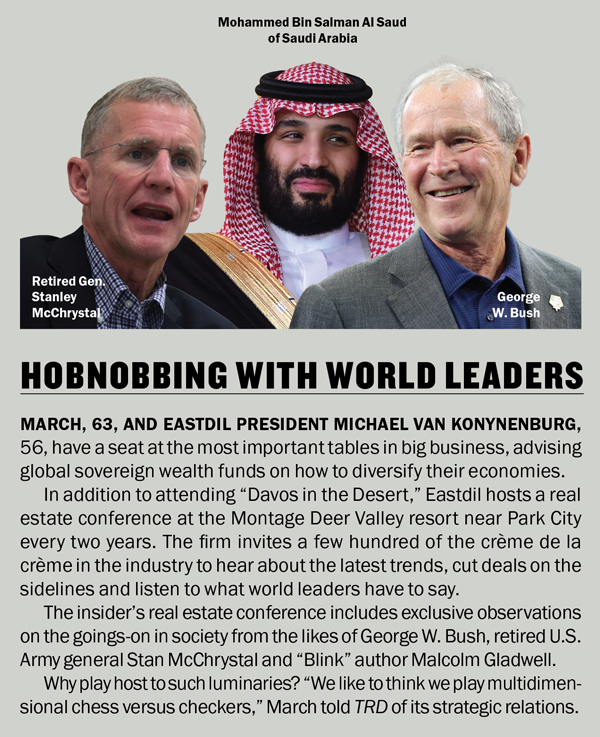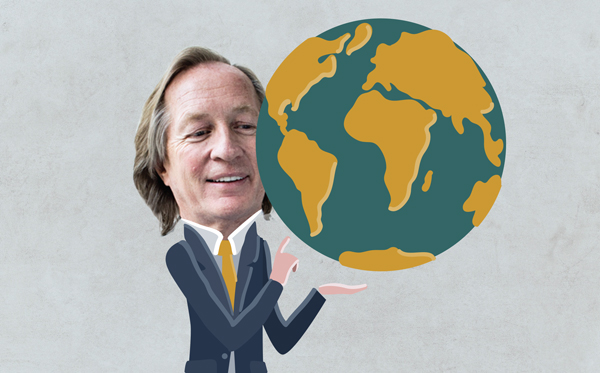Over Kobe steaks at the Michelin-starred Beefbar in Hong Kong, Roy March and Goodwin Gaw were chatting in hushed tones. They traded notes on their Ferraris and detailed their recent travels, but as the meal drew to a close, the longtime friends, March the chief executive of Eastdil Secured and Gaw the managing principal of Gaw Capital Partners, got around to one of the key reasons for their dinner: Eastdil’s expansion plans in Asia. For one, which local brokers should the firm poach from rivals?
“He leverages partnerships across the world,” Gaw said of March in a recent telephone interview. Gaw is a trusted confidante of March and has involved Eastdil in “30 to 40 transactions” over the years, including his company’s $325 million purchase of the sprawling Hollywood & Highland Center entertainment complex last summer.
“The topic of conversation is the industry and what part of the world to expand,” Gaw said. “We talk shop, his hiking expeditions and climbing.”
Led by the swashbuckling March, Eastdil Secured has been at the top of the commercial real estate heap for a decade-plus now. Whether he’s pressing the flesh at Davos, talking with government leaders in Riyadh, Saudi Arabia, or introducing former U.S. President George W. Bush at an invitation-only real estate conference in Park City, Utah, the floppy-haired 63-year-old puts himself where the power brokers are.
By extension, his firm’s list of deals reads like a timeline of the market itself: Eastdil brokered Blackstone Group’s $39 billion deal for the Equity Office portfolio in 2007, Anbang Insurance Group’s $2 billion deal for New York’s Waldorf Astoria in 2015 and a good chunk of trophy office trades in New York City and Los Angeles over the past decade.
And after pulling off a management-led buyout of Eastdil from majority owner Wells Fargo, March and firm president Michael Van Konynenburg are in the midst of expanding the firm’s reach on a global scale.
With the turmoil in the Middle East, Brexit, Hong Kong and tit-for-tat saber-rattling with Iran, Eastdil is stepping forward to help major investors find new areas of investment in commercial real estate through newly opened offices in Germany, France, Japan, Singapore and elsewhere.
The executives want Eastdil to become “the firm of choice” for global wealth funds looking to diversify into real estate. For instance, Saudi Arabia is going from an oil-based economy to a more diverse one. After Eastdil’s management-led buyout last fall, March attended “Davos in the Desert” in Riyadh to meet with government and business leaders to network.
 Formally known as the Future Investment Initiative, the annual forum is seen as a window into the Public Investment Fund of Saudi Arabia, one of the world’s largest sovereign wealth funds, which is seeking to develop sectors like health care, infrastructure and tourism. The Eastdil team has attended the event for the last three years — Van Konynenburg participated in 2017 and March in 2019.
Formally known as the Future Investment Initiative, the annual forum is seen as a window into the Public Investment Fund of Saudi Arabia, one of the world’s largest sovereign wealth funds, which is seeking to develop sectors like health care, infrastructure and tourism. The Eastdil team has attended the event for the last three years — Van Konynenburg participated in 2017 and March in 2019.
Qatar also is of interest for Eastdil as it has become one of New York City’s biggest commercial real estate investors in recent years.
Essentially, Eastdil wants to play dealmaker as global turmoil creates new opportunities for investments in commercial real estate, which is seen as a source of stable income.
“We are spending a lot of time with these major investors as we assist them in identifying places to place that capital in a very low-yielding world,” Van Konynenberg said.
The management-led buyout of the majority of Wells Fargo’s stake in Eastdil was a victory for March, who has worked for the firm for more than 40 years. Wells Fargo bought Eastdil in 1999, and March became CEO in 2006 when Eastdil merged with Secured Capital. Since October, Wells Fargo has cut its stake in Eastdil to less than 10 percent.
The company is now free from the regulatory constraints of being owned by Wells Fargo. By bringing in investment from Guggenheim Investments and Singapore investment company Temasek Holdings, Eastdil is positioning itself to compete with its much larger rivals, the “big three” – L.A.-based CBRE, Chicago-based Cushman & Wakefield and Chicago-based JLL.
Eastdil has already dominated larger commercial real estate markets in New York City and other major cities for years. It was the No. 1 ranked broker for U.S. deals over $100 million from 2015 to 2018, according to data supplied by Real Capital Analytics.
In 2019, Eastdil completed more than $253 billion in global capital market transactions, which included both debt and equity placements, according to figures provided by the company.
One of the biggest players in the market has a long-standing relationship with the firm. Colony Capital, a $49 billion dollar real estate investment firm headquartered downtown, is lead by Tom Barrack, a close personal friend of President Trump with strong ties to the Middle East — Qatar in particular. The firm has had “a very long-standing relationship with Eastdil,” according to Colony President Darren Tangen. He pointed to Eastdil’s recent advisory involvement in the $5.7 billion sale of 60 million square feet of last-mile industrial assets to Blackstone as evidence of the firm’s heft in the field.
“I’ve been here for 18 years, and they’ve been involved in every single year in some deal,” Tangen said, noting the efficiency and speed by which Eastdil conducted a three-month-long auction to sell the industrial assets to Blackstone.
“That’s one of Eastdil’s strong suits, their ability to put together a transaction of this size,” Tangen said. “There are very few others who have the track record, percentage of market share and breadth of relationships to do these large transactions this quickly.”
Growing global reach
Eastdil has always been an anomaly, seeing itself not as a brokerage but as a real estate investment bank. With about 350 brokers, analysts and executive managers in 16 locations, the firm is dwarfed in head count by players like the publicly traded big three. Unlike those firms, Eastdil can’t rely on leasing arms to win new work. Expansion is key.
In recent months, the big three have been buoyed by record stock trading highs and strong earnings as observers are seeing these industry consolidators as posing a competitive threat to Eastdil. This growing industry power concentrated in the hands of few was viewed as yet another catalyst for Eastdil to break free from Wells Fargo’s regulatory grip and look to grow outside of the U.S.

But Eastdil stands out from the pack in some respects. A selling point, from its own perspective, has been its compensation structure, which resembles more of what a Wall Street investment firm offers.
Its brokers take home a salary and bonuses, not commission, and they rarely leave the company. Managers act more like advisers in high-end deals, working closely with financing specialists who can tap into global resources.
“A traditional commission system incentivizes people to only focus on the specific team working with a client, limiting the willingness to use the full resources of a the platform,” Van Konynenburg said. “Furthermore, the recapitalization has benefitted our recruitment pipeline, as it allows us to offer a larger platform with greater geographic presence to generate more revenue and, consequently, greater compensation opportunity than a commission-based shop.”
The company took its first step outside of the United States in London in the early 2000s and has since added Hong Kong, Tokyo and Dubai. Since the management-led buyout was completed this fall, Eastdil has opened an office in Frankfurt, Germany.
The firm is also turning eastward.
“We will grow our presence in Asia,” he said. “Especially given that Temasek is a shareholder and gives us a significant growth opportunity.”
He said other moves to open offices in the region include Seoul, South Korea, and Singapore, where Temasek is headquartered. It also has two offices in Beijing and one each in Shanghai, Mumbai, India, Hanoi, Vietnam, and elsewhere.
The pace of expansion is speeding up, according to Van Konynenburg. He projected that over the next two to three years, the professional head count will hit 400 employees with another 125 administrative and operations employees, giving the firm a total workforce of 525. He doesn’t anticipate opening more offices in the U.S., where they currently have 10 locations.
Other real estate investment players are taking notice of Eastdil’s posturing outside of the U.S.
Paul Twardowski, who oversees the West Coast for real estate investment firm Hines, said his own Houston-based company is undergoing some restructuring within its ranks to reflect expansion in Asian and adjacent markets, including Australia.
“To some degree, with their new funding and their historically deep relations with investors across the world, Eastdil’s plans are in parallel with our own expansion in Asia,” Twardowski said. “I’d expect to overlap with them frequently in the future.”
Contrition for attrition?
As Eastdil moves forward, it is still recovering from setbacks of the recent past. The firm had ruled the New York investment sales market for three consecutive years until 2016 when top-producing New York brokers Doug Harmon and Adam Spies decamped for Cushman & Wakefield.

The impact is evident: The brokerage ranked third in The Real Deal’s most recent ranking of top investment-sales firms in New York, brokering about $5.9 billion worth of deals. But the firm had taken the top spot on the ranking seven years in a row from 2010 to 2016. And while Eastdil more than doubled its dollar volume from 2017 to 2018, the 2018 earnings are still a fraction of the $22.7 billion it closed in 2015.
March and Van Konynenburg bristle over any talk of the two brokers creating any lasting battle scars to the company after they left.
As of mid-December, Eastdil’s New York team had advised on over $10 billion of financing and sales of New York City assets and another $8 billion-plus in out-of-market transactions in 2019, Van Konynenburg said.
Over in L.A. County, the company reports that financings and sales were $14 billion in 2019. In all of Southern California, Eastdil saw a total of $18 billion in deals in 2019.
The company is currently strengthening its bench in New York — perhaps at the expense of L.A.
Van Konynenburg confirmed that one of Eastdil’s top brokers in Los Angeles is moving to the East Coast to boost the firm’s investment sales and debt placement teams in New York.
Jonathan Firestone, a managing director, has worked at Eastdil’s L.A. office for the past 18 years. The 46-year-old is a member of the management committee and started in the Manhattan office in January.
Van Konynenburg said that Eastdil tapped Firestone, who began his career in New York, “to further drive the firm’s growth as part of our new structure.”
The fallout from expansion
Some analysts say the move to go private by Eastdil may lead to a shakeup among its leadership and prominent departures to competitors.
“Going forward, you’ll definitely see some management changes and layoffs,” said Yousef Hafuda, an industry analyst with Morningstar. “We’ve not seen evidence of that yet.
“The push is for all players to be present in all geographies as much as possible,” he said of the big three. “I’d expect Eastdil to do the same, shifting to different geographies and different business lines.”
Van Konynenburg for one plans to stick to his knitting. He is betting it can prosper as an independent boutique operation even as its competitors are growing bigger and going public.
Meanwhile, he plans to focus on growing its technology and use capital to expand in the Sun Belt, Germany, France and Asia. “I do not see anything on the horizon for a material acquisition,” he said.
